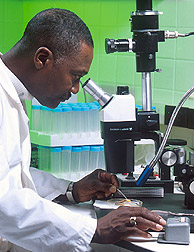 Israeli breakthrough could be key to finding solution for destroying human immunodeficiency virus before it progresses to AIDS.
Israeli breakthrough could be key to finding solution for destroying human immunodeficiency virus before it progresses to AIDS.
Similarities between leukemia and HIV recently discovered in an Israeli lab might provide important clues in the search for a clinical solution to prevent and destroy the human immunodeficiency virus, which can lead to the chronic and fatal condition AIDS.
Microbiology and immunology researchers in the lab of Prof. Ran Taube at Ben-Gurion University of the Negev (BGU) say their discovery is a significant breakthrough.
Until now, medical researchers had very limited information on the existence of a connection between AIDS, caused by the HIV virus, and a rare blood cancer, known as mixed lineage leukemia (MLL),” explained Taube. “MLL, found mostly in children, hinders blood-system cell development.
In MLL, there is damage to the reproduction mechanisms that normally control the expression of the genes responsible for manufacturing stem cells in the bone marrow. Taube said something similar happens with the HIV virus when it enters a chronic state.
“This research is based on the assumption that damage to the mechanisms of expression and reproduction of the viral genome is responsible for the accumulation of the latent HIV virus and leads to the chronic disease condition,” said Taube, whose lab focuses on understanding viral-host interactions that promote human diseases.
This article has been republished with permission by www.ISRAEL21c.org. Click here to continue reading.




